Powell and Pressburger: In Prospero's Room | reviews, news & interviews
Powell and Pressburger: In Prospero's Room
Powell and Pressburger: In Prospero's Room
A magical day at Derek Jarman’s Dungeness cottage, dancing with the ghosts of Shakespeare, Powell and Pressburger

There’s a thread of bright magic running through British cinema, from Powell and Pressburger through Nic Roeg, Derek Jarman and Lynne Ramsay, and it’s wrapped around Jarman’s last home like fisherman’s rope.
His friend and collaborator Tilda Swinton called Prospect Cottage a charged place, acting as a battery for artists. It is particularly so this weekend, as the BFI’s Powell and Pressburger season sparks the first art made here since Jarman’s death in 1994. Powell + Pressburger: In Prospero’s Room draws on an obscure but profound connection. Jarman adapted Shakespeare’s The Tempest in 1979, partly inspired by the BFI’s 1978 Powell and Pressburger season. He made fallen aristocrat-magician Prospero’s castle a place of candle-glow and deep shadow, grotesque power-plays and sexual liberation, haunted silence and camp, intensely moving MGM musical song and dance, on an island shrouded in dislocating blue fog. Poet-magician Heathcote Williams played Prospero with quiet incantatory power, with punk singer Toyah Wilcox, pictured below, as his innocently erotic daughter Miranda.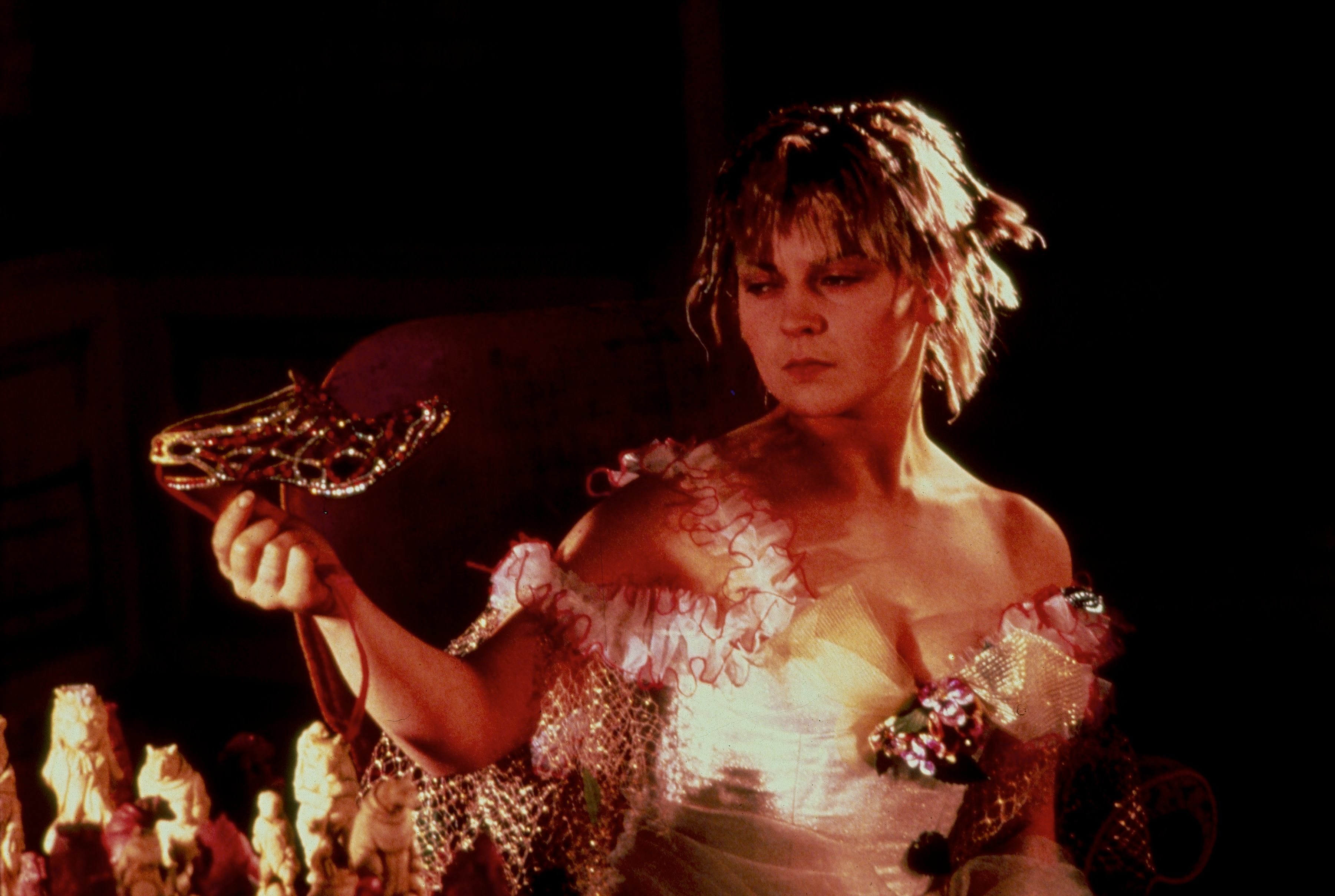 Michael Powell meanwhile tried to make his own Tempest for 15 years, with James Mason as Prospero. He said the play contained “all the things that I loved and believed in”, and came closest to filming it out of all his unrealised projects, after the scandalous Peeping Tom (1960) all but ended his career. “When I was making The Tempest… I kept saying to my producer, ‘Michael Powell should be making this – I’ve stolen it from him,’” Jarman confessed to interviewer Ian Christie. Both men shared the idea of the director as Prospero-like magus. “It’s very difficult to deal with our culture mythically,” Jarman considered to Christie, pointing to Powell and Pressburger’s The Life and Death of Colonel Blimp (1943) and A Canterbury Tale (1944) as rare exemplars, and the latter’s manipulative, tragic magistrate Thomas Colpepper (Eric Portman) – who appears satyr-like in the Kentish fields he reveres – as a Prospero-manque. In Prospero’s Room therefore scatters mementos of both men’s Tempests through Prospect Cottage, alongside film art responding to Powell and Pressburger’s rapturous visions.
Michael Powell meanwhile tried to make his own Tempest for 15 years, with James Mason as Prospero. He said the play contained “all the things that I loved and believed in”, and came closest to filming it out of all his unrealised projects, after the scandalous Peeping Tom (1960) all but ended his career. “When I was making The Tempest… I kept saying to my producer, ‘Michael Powell should be making this – I’ve stolen it from him,’” Jarman confessed to interviewer Ian Christie. Both men shared the idea of the director as Prospero-like magus. “It’s very difficult to deal with our culture mythically,” Jarman considered to Christie, pointing to Powell and Pressburger’s The Life and Death of Colonel Blimp (1943) and A Canterbury Tale (1944) as rare exemplars, and the latter’s manipulative, tragic magistrate Thomas Colpepper (Eric Portman) – who appears satyr-like in the Kentish fields he reveres – as a Prospero-manque. In Prospero’s Room therefore scatters mementos of both men’s Tempests through Prospect Cottage, alongside film art responding to Powell and Pressburger’s rapturous visions.
Prospect Cottage feels like an island as it’s approached past Dymchurch and Lydd, till all that’s left are Dungeness’s shanty-like fisherman’s cottages, exposed to the elements on the shingled beach. Flat Kent marshland and sea surround you, the grey skies and rolling waves tempestuous enough, the low horizon lined by pylons, and otherwise broken by lighthouses and a squat nuclear power station. Prospect Cottage’s timber-planked walls and tarred tin roof are black, with bright yellow window-frames. Jarman’s garden is made of rusting flotsam, stone circles and pebble-skull sculptures, like a series of spells marking his territory. He moved here in 1986 as AIDS afflicted him, and it is a house to work in with collaborators, amidst elemental nature, away from unwanted human distraction.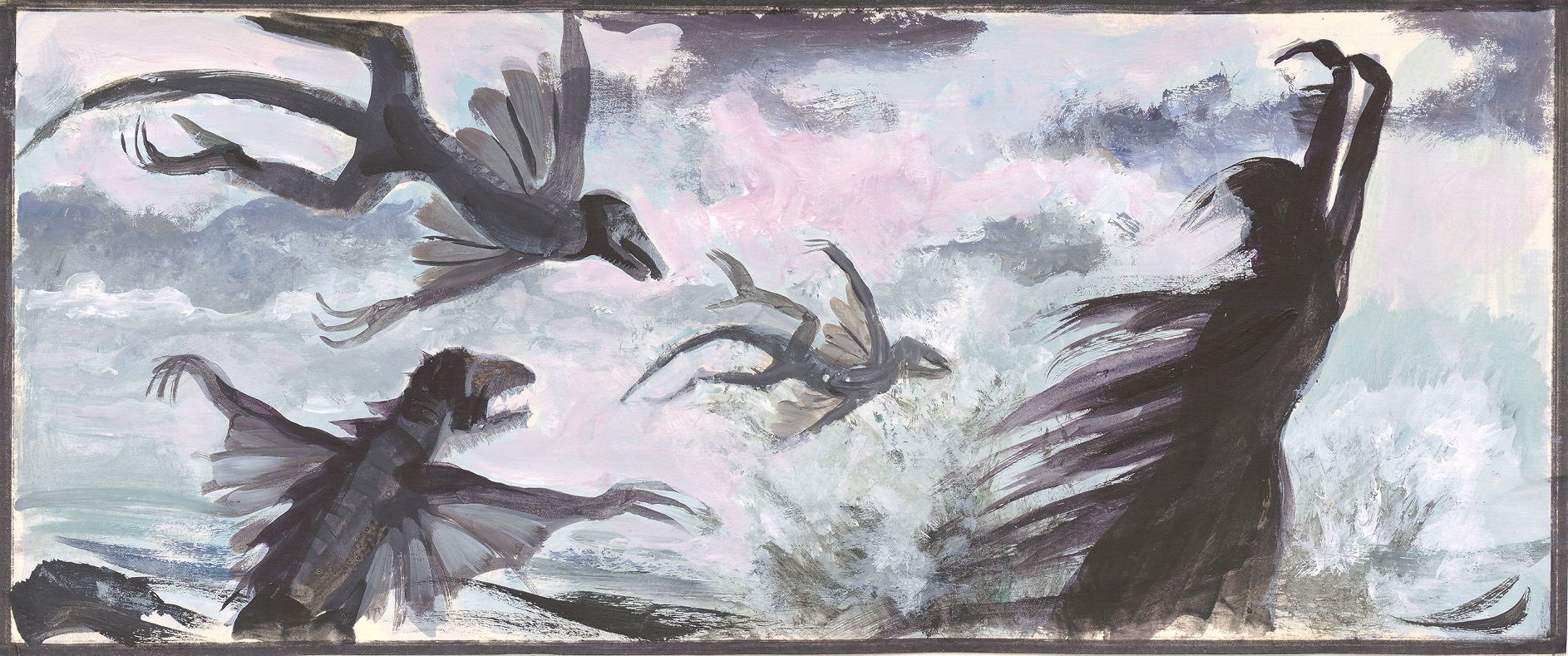 In Prospero’s Room subtly remakes four rooms. The conservatory offers Ivor Beddoes’ early Seventies production designs for Powell’s Tempest, left on the sofa as if Powell just perused them, and framed and draped along the walls. Beddoes had worked with Powell since Black Narcissus (1947), and perfectly understood his unfashionable desire for Prospero’s island to be “completely un-naturalistic… everything in a studio set or painting”, inspired by the lost, prehistoric kingdoms of Jules Verne, Conan Doyle and King Kong, and Goya and Bosch. Painted sketches show lizard-birds at the bidding of a feathery figure, surely Ariel and his creatures, pictured above. Larger, pastel paintings show Prospero’s castle as a ruined, once civilised headland off a storm-darkened mountain spine (pictured below) and, still more tantalisingly, gold-cloaked Prospero in a circle of light and outer runic ring as Ariel ascends with the sun, suggesting the risen Christ. You can see Beddoes’ rough, shaping lines beneath the paint, the hand-drawn start of unmade magic. Like Kubrick’s Napoleon, this suggested film grows in the mind. The conservatory’s extant artefacts include one of the Cottage’s many carved Christs, this one crucified on a small buzzsaw, and Jarman’s gardening gloves.
In Prospero’s Room subtly remakes four rooms. The conservatory offers Ivor Beddoes’ early Seventies production designs for Powell’s Tempest, left on the sofa as if Powell just perused them, and framed and draped along the walls. Beddoes had worked with Powell since Black Narcissus (1947), and perfectly understood his unfashionable desire for Prospero’s island to be “completely un-naturalistic… everything in a studio set or painting”, inspired by the lost, prehistoric kingdoms of Jules Verne, Conan Doyle and King Kong, and Goya and Bosch. Painted sketches show lizard-birds at the bidding of a feathery figure, surely Ariel and his creatures, pictured above. Larger, pastel paintings show Prospero’s castle as a ruined, once civilised headland off a storm-darkened mountain spine (pictured below) and, still more tantalisingly, gold-cloaked Prospero in a circle of light and outer runic ring as Ariel ascends with the sun, suggesting the risen Christ. You can see Beddoes’ rough, shaping lines beneath the paint, the hand-drawn start of unmade magic. Like Kubrick’s Napoleon, this suggested film grows in the mind. The conservatory’s extant artefacts include one of the Cottage’s many carved Christs, this one crucified on a small buzzsaw, and Jarman’s gardening gloves.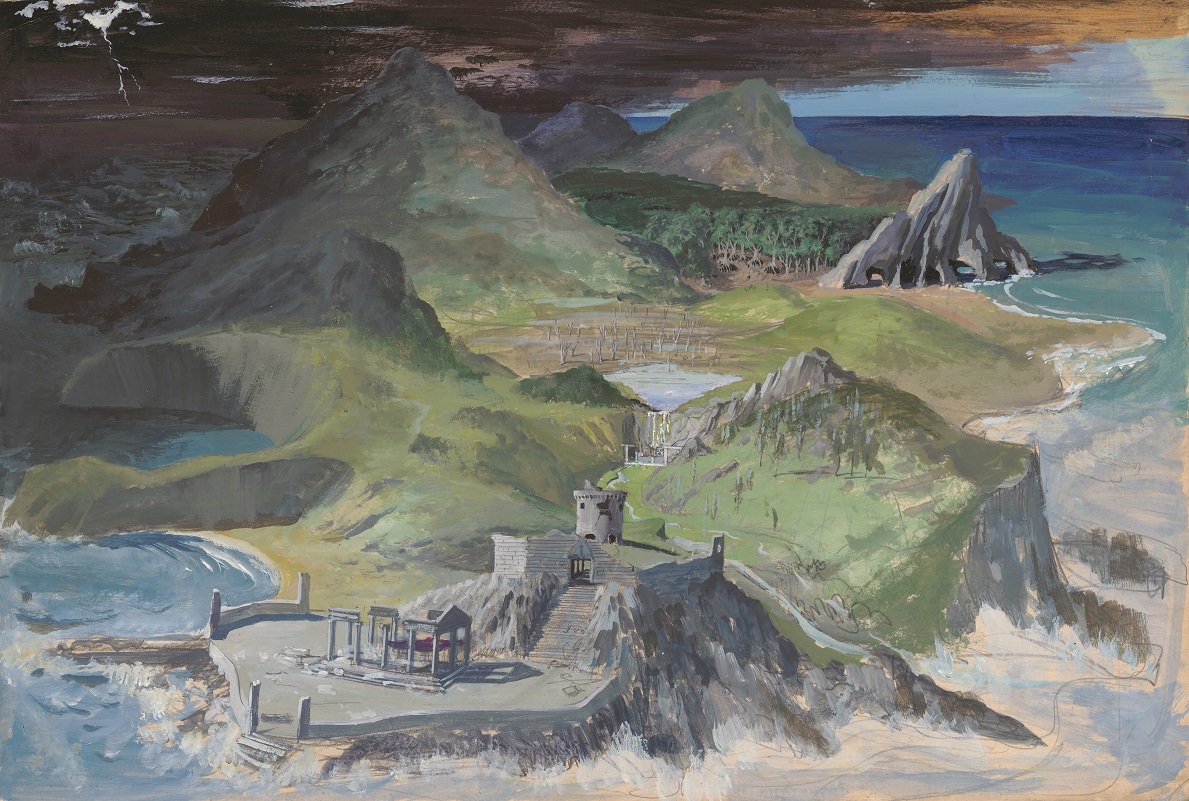 Jarman’s other rooms are wood-panelled cabins, enclosed as if at sea. In his workshop, his Tempest now plays on DVD, one of several mesmeric Jarman or Powell-derived murmurs in Prospect Cottage today. Look away, and Heathcote Williams’ silky tones as Prospero irresistibly suggest Vincent Price. Glass-panelled bookcases contain Arthur Mee’s set of county guides, The King’s England, Jarman’s collection of books on Elizabethan magus and reputed Prospero model John Dee, and dark-blue, crystal-like balls from Aleister Crowley, the self-styled Wickedest Man in the World who died down the coast in a Hastings B&B. Jarman’s Tempest production sketches are slipped inside the glass, including his Prospero profile: “Black shiny costume like Robespierre… Prospero is black and white – part earth & part magic”.
Jarman’s other rooms are wood-panelled cabins, enclosed as if at sea. In his workshop, his Tempest now plays on DVD, one of several mesmeric Jarman or Powell-derived murmurs in Prospect Cottage today. Look away, and Heathcote Williams’ silky tones as Prospero irresistibly suggest Vincent Price. Glass-panelled bookcases contain Arthur Mee’s set of county guides, The King’s England, Jarman’s collection of books on Elizabethan magus and reputed Prospero model John Dee, and dark-blue, crystal-like balls from Aleister Crowley, the self-styled Wickedest Man in the World who died down the coast in a Hastings B&B. Jarman’s Tempest production sketches are slipped inside the glass, including his Prospero profile: “Black shiny costume like Robespierre… Prospero is black and white – part earth & part magic”.
Jarman’s reproduced, hand-written Tempest thesis lies by the TV where the film plays. He means to resolve Shakespeare’s “narrative drifting… like the enigmatic music which haunts the island”, and “recapture...the mystery and atmosphere of the original work”: “a highly topical political play for an audience who believed in the reality of its magic”. “There are films where magic work,” he says, an ambition he shared with Powell and Pressburger, and notes examples: the “mesmeric alienating world” of The Cabinet of Dr Caligari, and Bergman’s The Hour of the Wolf, “in which the whole landscape is alive with apparitions and malevolent dreams”. Drawing on “Freud and particularly Jung”, he hoped to convince Seventies audiences of The Tempest’s spell. The paint-pots and spattered furniture of the cinema wizard who wrote these notes, his self-portrait and Maggi Hambling’s blue, posthumous painting of him already fill this net-curtained room, darkened by today’s wintry shadows.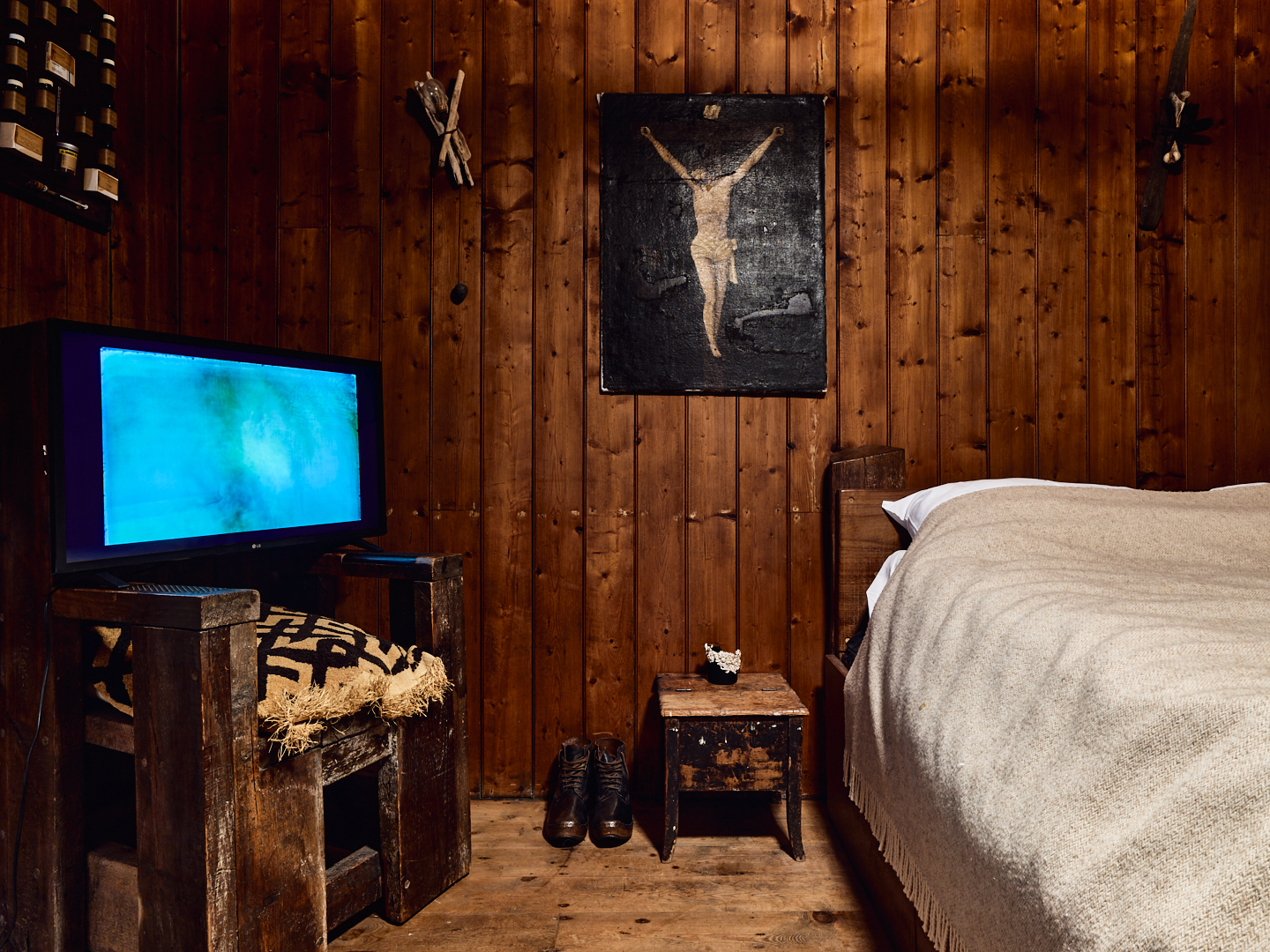 In Jarman’s bedroom across from his neatly made bed, pictured above, film artist Adebukola Bodunrin’s three-minute video Even When Life Is Sad, People Still Have a Good Time (2005) rips and dissolves Moira Shearer’s dancing in Powell and Pressburger’s The Tales of Hoffman (1951), as if the footage is being elementally assaulted by fire and water, and slashed by lightning. In the front room, Powell’s German TV adaptation of Bartók’s opera Bluebeard’s Castle (1963), a rare work from the director’s twilight, glistens with crystalline colour, its painterly artifice showing his fraternity with Jarman. In the study, pictured below, the room heaviest in atmosphere with its dark furniture and frame, words and images from weird wartime fable A Canterbury Tale are manipulated in Victor Burgin’s video Listen to Britain, made under 9/11’s war cloud.
In Jarman’s bedroom across from his neatly made bed, pictured above, film artist Adebukola Bodunrin’s three-minute video Even When Life Is Sad, People Still Have a Good Time (2005) rips and dissolves Moira Shearer’s dancing in Powell and Pressburger’s The Tales of Hoffman (1951), as if the footage is being elementally assaulted by fire and water, and slashed by lightning. In the front room, Powell’s German TV adaptation of Bartók’s opera Bluebeard’s Castle (1963), a rare work from the director’s twilight, glistens with crystalline colour, its painterly artifice showing his fraternity with Jarman. In the study, pictured below, the room heaviest in atmosphere with its dark furniture and frame, words and images from weird wartime fable A Canterbury Tale are manipulated in Victor Burgin’s video Listen to Britain, made under 9/11’s war cloud.
These artistic interventions benignly haunt and enliven Jarman’s old rooms, and invoke an intimate, living relationship with Powell, Pressburger and beyond. Stepping outside on this indifferent grey day, the landscape which cradled the gradually debilitated Jarman’s last, intensely productive eight years has an inherent English beauty.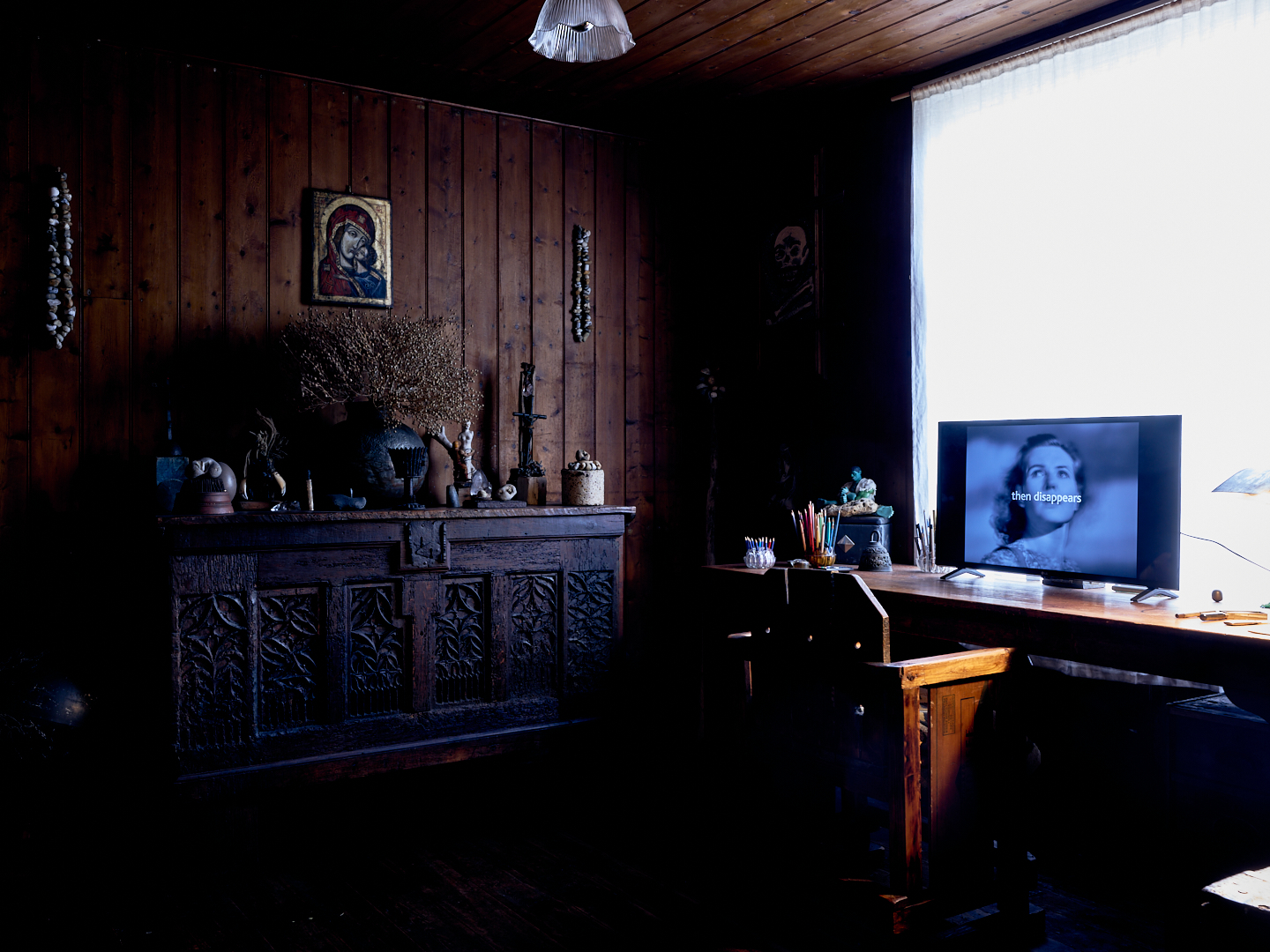 The BFI’s Powell and Pressburger celebration has one more treat on the day of my visit. In an annex of Folkestone’s Gothically dark former hotel the Grand, Jarman’s regular costume designer Sandy Powell (later a triple-Oscar-winner and Scorsese foil) is interviewed alongside another of his Eighties collaborators, set designer Simon Costin. With the softly curved line of her red hair and red ankle-boots, Powell still looks the part of a life she now recognises was indirectly influenced by Powell and Pressburger, via her teenage love of Bowie and awareness of his dance hero Lindsay Kemp, who she sought out for work in 1980. “Looking back, everything about Lindsay was The Red Shoes and The Tales of Hoffman,” she says. “He might have been dancing down the street, or dancing in a bar, but it was The Red Shoes.” With both Kemp and Jarman, “the theatricality in their work you can trace back to Powell and Pressburger… a heightened reality… I think that’s the bit that I’ve taken.”
The BFI’s Powell and Pressburger celebration has one more treat on the day of my visit. In an annex of Folkestone’s Gothically dark former hotel the Grand, Jarman’s regular costume designer Sandy Powell (later a triple-Oscar-winner and Scorsese foil) is interviewed alongside another of his Eighties collaborators, set designer Simon Costin. With the softly curved line of her red hair and red ankle-boots, Powell still looks the part of a life she now recognises was indirectly influenced by Powell and Pressburger, via her teenage love of Bowie and awareness of his dance hero Lindsay Kemp, who she sought out for work in 1980. “Looking back, everything about Lindsay was The Red Shoes and The Tales of Hoffman,” she says. “He might have been dancing down the street, or dancing in a bar, but it was The Red Shoes.” With both Kemp and Jarman, “the theatricality in their work you can trace back to Powell and Pressburger… a heightened reality… I think that’s the bit that I’ve taken.”
“It was an awareness that there’s a parallel world running alongside this one,” Costin says of Powell and Pressburger’s importance, “a magical world, just beyond the veil.” It’s Prospero again, whose boundless realm also runs through Blake and British literary inheritors including Michael Moorcock and Alan Moore, whose own last comic, The League of Extraordinary Gentlemen: The Tempest (2018-19) saw him pictured in the guise of Prospero, plotting the magical world’s conquest of oppressive, prosaic reality. The last issue of Neil Gaiman’s The Sandman, too, was titled “The Tempest”, with Shakespeare’s writing of his final play interlaced with that fantasy epic’s end.
Powell’s tales of Scorsese, Jarman and the Powell and Pressburger-indebted Neil Jordan (think of the Dubliner’s richly artificial English fantasias from The Company of Wolves to Byzantium) end with a consideration of an “extraordinary set of creative relationships” begun in Seventies and Eighties New York. It was here that Scorsese revived Michael Powell’s standing, The Red Shoes and Powell himself influenced Raging Bull, and Scorsese’s indispensable editor ever since, Thelma Schoonmaker, met and married Powell. Powell was of course a Kentish man, and on this long day in the county where he was raised and Derek Jarman found a home, their marvellous skein of English genius breathes again.
rating
Share this article
more Film
 Blu-ray: The Dreamers
Bertolucci revisits May '68 via intoxicated, transgressive sex, lit up by the debuting Eva Green
Blu-ray: The Dreamers
Bertolucci revisits May '68 via intoxicated, transgressive sex, lit up by the debuting Eva Green
 theartsdesk Q&A: Marco Bellocchio - the last maestro
Italian cinema's vigorous grand old man discusses Kidnapped, conversion, anarchy and faith in cinema
theartsdesk Q&A: Marco Bellocchio - the last maestro
Italian cinema's vigorous grand old man discusses Kidnapped, conversion, anarchy and faith in cinema
 I.S.S. review - sci-fi with a sting in the tail
The imperilled space station isn't the worst place to be
I.S.S. review - sci-fi with a sting in the tail
The imperilled space station isn't the worst place to be
 That They May Face The Rising Sun review - lyrical adaptation of John McGahern's novel
Pat Collins extracts the magic of country life in the west of Ireland in his third feature film
That They May Face The Rising Sun review - lyrical adaptation of John McGahern's novel
Pat Collins extracts the magic of country life in the west of Ireland in his third feature film
 Stephen review - a breathtakingly good first feature by a multi-media artist
Melanie Manchot's debut is strikingly intelligent and compelling
Stephen review - a breathtakingly good first feature by a multi-media artist
Melanie Manchot's debut is strikingly intelligent and compelling
 DVD/Blu-Ray: Priscilla
The disc extras smartly contextualise Sofia Coppola's eighth feature
DVD/Blu-Ray: Priscilla
The disc extras smartly contextualise Sofia Coppola's eighth feature
 Fantastic Machine review - photography's story from one camera to 45 billion
Love it or hate it, the photographic image has ensnared us all
Fantastic Machine review - photography's story from one camera to 45 billion
Love it or hate it, the photographic image has ensnared us all
 All You Need Is Death review - a future folk horror classic
Irish folkies seek a cursed ancient song in Paul Duane's impressive fiction debut
All You Need Is Death review - a future folk horror classic
Irish folkies seek a cursed ancient song in Paul Duane's impressive fiction debut
 If Only I Could Hibernate review - kids in grinding poverty in Ulaanbaatar
Mongolian director Zoljargal Purevdash's compelling debut
If Only I Could Hibernate review - kids in grinding poverty in Ulaanbaatar
Mongolian director Zoljargal Purevdash's compelling debut
 The Book of Clarence review - larky jaunt through biblical epic territory
LaKeith Stanfield is impressively watchable as the Messiah's near-neighbour
The Book of Clarence review - larky jaunt through biblical epic territory
LaKeith Stanfield is impressively watchable as the Messiah's near-neighbour
 Back to Black review - rock biopic with a loving but soft touch
Marisa Abela evokes the genius of Amy Winehouse, with a few warts minimised
Back to Black review - rock biopic with a loving but soft touch
Marisa Abela evokes the genius of Amy Winehouse, with a few warts minimised
 Civil War review - God help America
A horrifying State of the Union address from Alex Garland
Civil War review - God help America
A horrifying State of the Union address from Alex Garland

Add comment